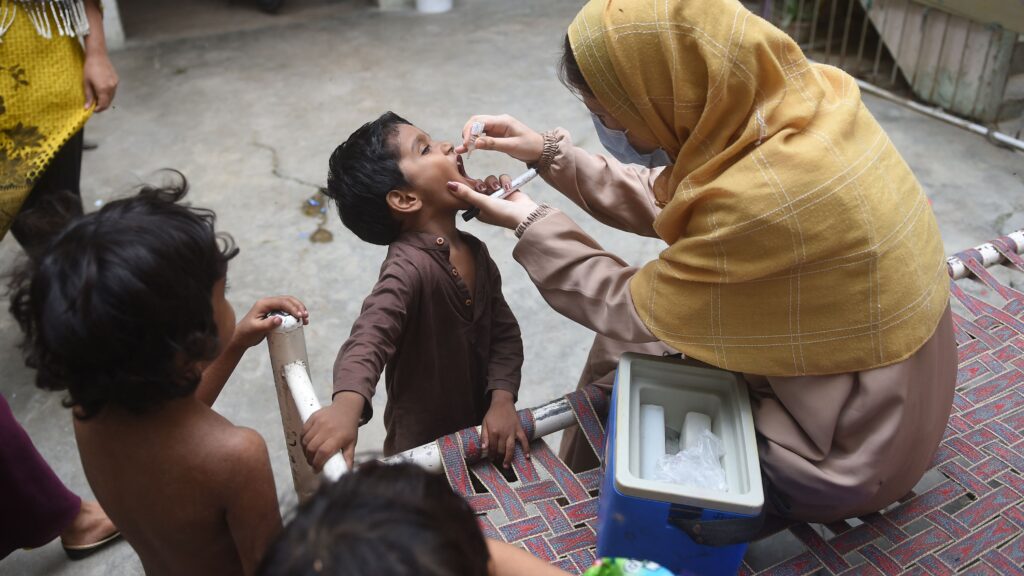The latest goal for the end of polio transmission will almost certainly not be met, according to a frank and concerning report about the future of the decades-long polio eradication effort that was released this week.
After having missed multiple deadlines for ending polio transmission, the Global Polio Eradication Initiative had set 2023 as the year when both wild polio viruses would finally be snuffed out and so-called vaccine-derived viruses would also be stopped, putting an end to a family of viruses that have paralyzed children for centuries.
advertisement
But a report from the polio program’s Independent Monitoring Board makes clear that goal is not yet in sight. Though there have only been seven wild polio cases recorded this year — in Afghanistan and Pakistan, the last redoubts of the wild viruses — there does not appear to be enough time left in 2023 to stop the still ongoing spread, the report concluded. It also noted that all the conditions for success are not in place.
“The IMB judges progress toward the first strategic goal as off track with a very high probability that it will be missed,” said the committee, chaired by Sir Liam Donaldson, a professor of public health at the London School of Hygiene and Tropical Medicine. “This is because the complexity of the continuing barriers to interrupting wild poliovirus transmission is too great to be resolved in an 18-week period.”
The four-person panel was even more pessimistic about the prospects of stopping vaccine-derived polio transmission this year, saying it was “in no doubt” that goal would be missed.
advertisement
The oral polio vaccine that has been the backbone of global efforts to eradicate the virus contain live, weakened viruses that are dripped into children’s mouths via a dropper. The oral vaccine doses protect the children who receive them. But those children shed the viruses in their stools. In locations where sanitation and hygiene are poor, they spread from child to child. In some cases that is beneficial; a vaccination round using oral polio vaccine will end up vaccinating more children than the vaccinators actually reach. But if the viruses continue to spread because vaccination coverage in an area is low, the vaccine viruses can regain the power to paralyze.
These circulating vaccine-derived polioviruses, or cVDPVs, as they are known, now paralyze many more children than wild polio viruses do. In 2023 alone, there have been as many as 240 children in a couple of dozen countries paralyzed by vaccine viruses.
The United States does not employ the oral polio vaccine, having shelved it more than two decades ago because of the risks associated with its use.
The IMB report was critical of the polio program for not having attacked the vaccine-derived polio problem as assiduously as it has focused on wild polio cases, saying its “approach to vaccine-derived poliovirus has been a turbulent journey marred by rigid attitudes, missed opportunities, lack of foresight, and an inability to adapt swiftly to evolving circumstances.”
It also warned that more trouble on this front could lie ahead. In recent years, most of the vaccine-derived polio cases have been type 2 vaccine viruses. (There were originally three strains of wild polio, and vaccines to target each.) Campaigns to extinguish type 2 vaccine virus outbreaks have diverted resources from vaccination efforts aimed at protecting children against type 1 polio, the last of the wild type viruses in existence. The immunity gap for type 1 viruses presents an opportunity for type 1 vaccine viruses to take off — a prospect that could set back eradication efforts for years, the report warned.
Kim Thompson, president of the nonprofit organization Kid Risk and a mathematical modeler who has worked on polio eradication for decades, welcomed the bluntness of the IMB report on this and other issues. “If you don’t prevent the future outbreaks, then you have to deal with even more of them going forward,” Thompson said.
Vulnerability to this potential problem is especially acute in Nigeria, which has long struggled to control spread of vaccine viruses. The IMB report said that if type 1 vaccine virus transmission takes off in Nigeria, “the result could be catastrophic.” Nigeria, where security issues have hampered polio vaccination efforts in parts of the country, has at least 2.3 million children who have never received a dose of polio vaccine, the report noted.
In response to the IMB report, the Global Polio Eradication Initiative acknowledged the myriad challenges laid out in its 100-plus pages. “The GPEI remains confident that it can innovate and adapt in the face of this adversity to reach all children in the world’s most challenging settings,” it said in a statement. “Still, the IMB notes that without adequate financial resources and political commitment at all levels, the programme will not be able to fully implement needed solutions.”
Mark Pallansch, a longtime polio expert from the Centers for Disease Control and Prevention who is now retired, also credited the report for its frankness, though he had concerns about some of the issues it focused on. Pallansch fears the polio program has become too decentralized. “The program is not doing as good a job as it should in getting people to agree to what the priorities should be,” he said.
Pallansch worries that the program is not focusing as intensely as it needs to on the core task of immunizing children. “The virus tells us where the problems are,” he said. “If you see virus, you haven’t immunized children.”
The polio program is a partnership of the World Health Organization; the service club Rotary International; the CDC; UNICEF, the U.N. children’s fund; Gavi, the Vaccine Alliance; and the Bill and Melinda Gates Foundation.

